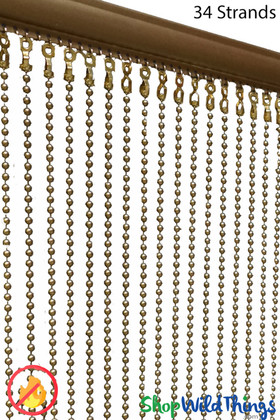Description
MADE IN the USA! Metal Lynx Chain Beaded Curtains ShopWildThings have long been made in our fabrication studio right here in Arizona! Our Aluminum Chain Metal Curtains are heavy duty and are used both in residential and commercial applications! Our latest giant high profile installation was for the 2024 Emmy Awards where we helped create giant hanging chain columns and arches of chain. We also offer Custom Ballchain 6mm Silver or 8mm Brass (Gold Color). Custom Orders are not cancelable once production has begun. Custom Orders are not returnable unless there is a defect in craftsmanship.
Need a Different Size?
On this page, order sections that are 3 feet wide. You can order them right online. If you need to order a different size, use our Custom Order Form to let us know what we can get done for you. The price per square foot for finished goods is $15.99 per square foot. We can make any exact size you'd like! Call us at 928-855-6075 or use our Custom Order Request Form to shoot us an email. We will provide a friendly no-obligation quote (and/or samples) during normal business hours Monday-Friday. Use this form to Request a Custom Quote.
Samples:
Do you need a small chain sample? We are happy to send you some! There is no charge for small chain samples sent regular mail to the lower 48 States USA. We can send Expedited/Rush Samples or send samples to more expensive shipping locations as well - we merely ask for you to pay for shipping. Call us at 928-855-6075 or use our Custom Order Request Form to shoot us an email. We will provide a friendly no-obligation quote (and/or samples) during normal business hours Monday-Friday. Use This Form to Request Samples.
Stock Sizes: If you are looking for "Stock" Curtains (ready to ship in large quantities at lower prices) please see THIS PAGE.
Weight:
These Metal Chain Curtains are heavier than the 5 pounds indicated at the top of the page. For every foot added, your curtain will be about 3 pounds heavier. If you need a final hanging weight, please contact us prior to ordering.
Colors:
The colors available on this page are usually in-stock and can be made in our regular fabrication schedule here in Arizona!
Custom Top Options:
Bendable Metal, Straight Metal, or Fabric Straps. There is a service upcharge for fabric straps, and for painting the metal rods to match the chain. Included with no upcharge are: Silver Metal or Matte Black.
Color Details: Our Chain is Anodized:
Anodizing is an electrochemical process that converts the metal surface into a decorative, durable, corrosion-resistant, anodic oxide finish. Aluminum is ideally suited to anodizing, although other nonferrous metals, such as magnesium and titanium, also can be anodized.
The anodic oxide structure originates from the aluminum substrate and is composed entirely of aluminum oxide. This aluminum oxide is not applied to the surface like paint or plating, but is fully integrated with the underlying aluminum substrate, so it cannot chip or peel. It has a highly ordered, porous structure that allows for secondary processes such as coloring and sealing.
Anodizing is accomplished by immersing the aluminum into an acid electrolyte bath and passing an electric current through the medium. A cathode is mounted to the inside of the anodizing tank; the aluminum acts as an anode, so that oxygen ions are released from the electrolyte to combine with the aluminum atoms at the surface of the part being anodized. Anodizing is, therefore, a matter of highly controlled oxidation the enhancement of a naturally occurring phenomenon.























